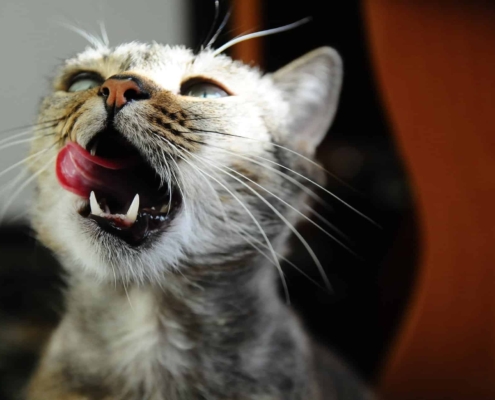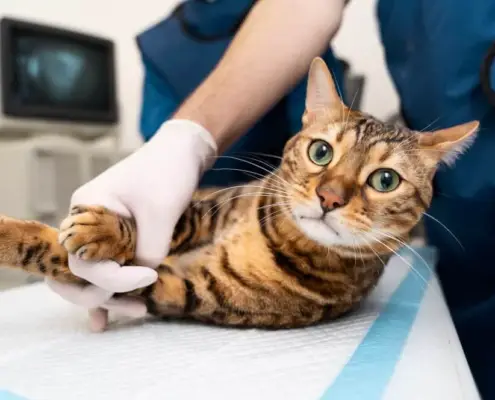
Rabies is a viral disease that affects the central nervous system of mammals, including cats. It is caused by the rabies virus, which is mainly transmitted through the bite of an infected animal. Rabies is a serious and often fatal disease, making it crucial for cat owners to understand the risks and take necessary precautions to keep their pets safe.
Cats infected with rabies may exhibit a range of symptoms, including behavioral changes, aggression, excessive salivation, difficulty swallowing, and paralysis. As the disease progresses, cats may become disoriented and display unusual vocalizations. It is important to note that not all infected cats will show these symptoms, and some may appear perfectly healthy while still being carriers of the virus.
The importance of rabies vaccinations for cats
Vaccination is the most effective way to protect cats against rabies. It is not only essential for the health and well-being of individual cats but also plays a crucial role in preventing the spread of the disease to other animals and humans. In many countries, rabies vaccinations are mandatory for cats, and failure to comply with vaccination requirements can result in legal consequences.
Cats should receive their first rabies vaccination around 12 weeks of age, with subsequent booster shots administered according to the recommended schedule. It is important to consult with a veterinarian to determine the appropriate vaccination protocol for your cat. Regular vaccinations not only provide protection against rabies but also help strengthen the overall immune system of your feline friend.
Signs and symptoms of rabies in cats
Recognizing the signs and symptoms of rabies in cats is crucial for early detection and prompt treatment. As mentioned earlier, infected cats may display behavioral changes, such as aggression or sudden fearfulness. They may also exhibit excessive drooling, difficulty swallowing, and a marked decline in appetite. In some cases, cats may develop a fear of water, which is a classic symptom of rabies.
As the disease progresses, cats may experience paralysis and become disoriented. They may wander aimlessly and may even attack without provocation. It is important to note that these symptoms can also be indicative of other health issues, so it is essential to consult with a veterinarian for an accurate diagnosis.
How rabies is transmitted to cats
Rabies is primarily transmitted through the bite of an infected animal. The virus is present in the saliva of infected animals and can enter the cat’s body through broken skin or mucous membranes. It is important to be aware that not all animals infected with rabies display obvious signs of the disease, which makes it crucial to exercise caution when interacting with unfamiliar animals, especially wildlife.
In rare cases, rabies can also be transmitted through scratches or when infected saliva comes into contact with open wounds. It is important to note that the virus does not survive long outside the body, so transmission through inanimate objects or environmental surfaces is highly unlikely.
Prevention and control of rabies in cats
Preventing and controlling rabies in cats involves a combination of vaccination, responsible pet ownership, and avoiding contact with potentially infected animals. Vaccination should be a top priority for cat owners, as it provides the best protection against the disease. In addition to keeping your cat up to date on vaccinations, it is important to keep them indoors and supervise outdoor activities to minimize the risk of exposure to infected animals.
Pet owners should also take steps to prevent their cats from coming into contact with wildlife, as these animals are more likely to carry the rabies virus. Secure outdoor areas with fences or enclosures, and keep garbage bins tightly sealed to discourage wildlife from venturing near your home. If you suspect a wild animal may be infected with rabies, contact your local animal control or wildlife authority for assistance.
What to do if your cat is exposed to rabies
If your cat has been exposed to a potentially rabid animal, it is important to take immediate action to protect both your pet and yourself. The first step is to contact your veterinarian for guidance. They will assess the situation and determine the appropriate course of action. In some cases, your cat may need to be quarantined for observation to rule out the presence of the virus.
If your cat is not up to date on rabies vaccinations or if the exposure is deemed high risk, your veterinarian may recommend post-exposure prophylaxis. This involves administering a series of rabies vaccinations to your cat over a specified period. It is important to follow your veterinarian’s instructions closely and monitor your cat for any signs of illness during the quarantine period.
The role of veterinarians in preventing and treating rabies in cats
Veterinarians play a critical role in preventing and treating rabies in cats. They are responsible for administering vaccinations, providing guidance on prevention strategies, and diagnosing and treating infected cats. Veterinarians are trained to recognize the signs of rabies and can provide accurate information and guidance to cat owners.
In addition to vaccinations, veterinarians may recommend additional preventive measures, such as flea and tick control, to reduce the risk of exposure to potential carriers of the virus. If your cat is showing symptoms of rabies or has been exposed to a potentially infected animal, it is important to seek veterinary care immediately. Early intervention can significantly improve the chances of a positive outcome.
Rabies laws and regulations for cat owners
Rabies laws and regulations vary by region, but in many countries, cat owners are legally required to have their cats vaccinated against rabies. Failure to comply with these laws can result in fines, penalties, or even the removal of the cat from your care. It is important to familiarize yourself with the specific laws and regulations in your area to ensure you are in compliance.
Additionally, some regions may have specific requirements for reporting potential rabies exposures or suspected cases. It is important to follow these reporting guidelines to help prevent the spread of the disease and protect public health. Your veterinarian can provide you with the necessary information and guidance regarding local laws and regulations.
Common misconceptions about rabies in cats
There are several common misconceptions about rabies in cats that need to be addressed. One of the most prevalent misconceptions is that indoor cats are not at risk of contracting rabies. While it is true that indoor cats have a lower risk compared to outdoor cats, they can still be exposed to the virus if an infected animal enters the home or if they are bitten by a bat that may have entered the house.
Another misconception is that only mammals can transmit rabies. While mammals are the primary carriers of the virus, there have been rare cases of birds and reptiles testing positive for rabies. It is essential to exercise caution and seek veterinary advice if your cat has been bitten or scratched by any animal, regardless of its species.
Keeping your cat safe from rabies
Rabies is a serious and potentially fatal disease that can affect cats. As responsible pet owners, it is our duty to protect our feline friends from this deadly virus. Vaccination is the most effective way to prevent rabies in cats, and it is crucial to follow the recommended vaccination schedule provided by your veterinarian. In addition to vaccination, responsible pet ownership, such as keeping cats indoors and avoiding contact with potentially infected animals, plays a significant role in preventing the spread of the disease.
If you suspect that your cat has been exposed to rabies or is showing symptoms of the disease, it is important to seek veterinary care immediately. Early detection and treatment can make a significant difference in the outcome. By understanding the risks, taking preventive measures, and staying informed about local laws and regulations, cat owners can ensure the safety and well-being of their beloved pets.
If you enjoyed my article, I would appreciate you sharing it with your network.

Sima Ndlebe
Sima writes for CatBuzz. He is interested in Cats, Health and Fitness, and Entrepreneurship.
Published: 11 October 2023
Related Articles
Disclaimer
The content found on CatBuzz.org is presented on an "as is" basis and is intended for general consumer information and education purposes only. Any utilization of this information is voluntary and solely at the user's own risk.
None of the articles or content should be regarded as, or used in place of, veterinary medical advice, diagnosis, or treatment. The information provided on the website is purely for educational and informational intentions and should not be considered a substitute for professional guidance from a veterinarian or other qualified expert. The articles are designed to inform consumers about veterinary healthcare and medical matters that may impact their cat's daily life. It should be noted that this website and its services do not constitute the practice of any form of veterinary medical advice, diagnosis, or treatment. CatBuzz.org explicitly disclaims any liability for any direct or indirect damages or losses that may arise from the use of or reliance on the information contained within the content.
Consumers must consult a veterinarian, veterinary specialist, or another qualified veterinary healthcare provider when seeking advice regarding their cat's health or medical conditions. It is important not to ignore, avoid, or postpone seeking medical advice from a veterinarian or other qualified veterinary healthcare provider solely based on information obtained from this website. If you believe that your cat may be experiencing a medical issue or condition, it is imperative to promptly contact a qualified veterinary healthcare professional.




